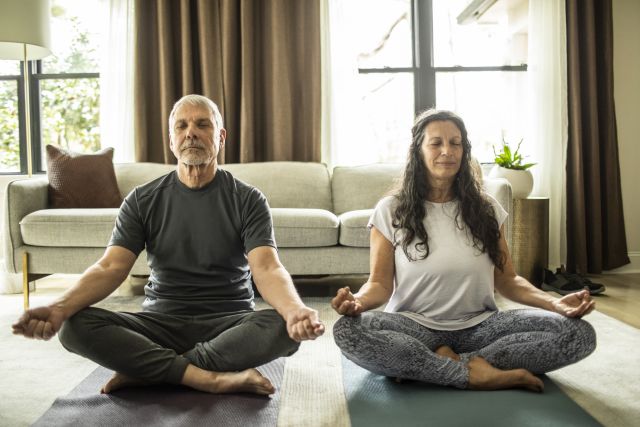Updated on July 16, 2024.
Do you have achy knees or a sore neck? Some research suggests that meditation may be a safe, drug-free method to help relieve pain. Here’s what to know about the science behind meditation and pain—plus ways you can try meditation for pain relief in your own life.
What is meditation?
The term meditation refers to practices that are used to induce a variety of mental and physical experiences, including:
- Fostering feelings of calm
- Developing concentration
- Creating awareness of bodily sensations and experiences
- Raising one’s overall well-being
Meditation practices have roots in many ancient traditions, particularly those originating in Eastern cultures. There are also many recent and modern forms of meditation.
One form of meditation called mindfulness meditation typically involves directing one’s mental attention to various areas of focus in the body. The most common of these is the breath.
For example, to practice mindfulness meditation, you might sit quietly and spend several minutes focusing your attention on the sensation of your breath flowing in and out at a specific place in your body. This might involve feeling your breath at your nostrils or noticing your belly rising and falling with each breath.
Other forms of meditation involve bringing one’s attention to sounds in the world around you, focusing on a word or phrase called a mantra, or directing thoughts or feelings of warmth or love to other people as you breathe. Spiritual meditation may involve a focus on aspects of one’s religion or spirituality.
Regardless of the form, a common goal of meditation is typically to develop a heightened awareness of one’s experience of the present moment, while letting go of judgments and feelings of craving or aversion.
While meditation tends to promote feelings of well-being, there’s been increasing interest in recent years about the benefits it may hold for physical and mental health.
Growth in popularity and scientific interest
In the 20th and 21st centuries, as meditation has become increasingly popular in Western cultures, science has begun to explore its benefits. According to the National Center for Complementary and Integrative Health (NCCIH), people who meditate have reported benefits including relaxation, less stress, better sleep, and even prevention of illness.
Because of those purported results—and the fact that it comes with few if any side effects—meditation practices have begun to be incorporated in many areas of modern life. For example, they’re often combined with stress-reduction programs for workers or offered as part of conflict resolution at schools. Meditation is also touted as helpful for memory and concentration. Mindfulness practices may also be incorporated into cognitive behavioral therapy (CBT).
Does meditation really have health benefits?
Some people believe that meditation can bring significant health benefits, such as stress relief, lower blood pressure, and better sleep. Some healthcare providers (HCPs) have incorporated it into programs to help ease several issues, including:
- Substance use disorder (SUD)
- Post-traumatic stress disorder (PTSD)
- Attention-deficit/hyperactivity disorder (ADHD)
There is a substantial body of research supporting the benefits for these uses and more.
Does meditation relieve pain?
Many practitioners of meditation believe that meditation can also help relieve pain. Research is ongoing but results of many studies so far have been encouraging.
In fact, the NCCIH itemizes more studies on the possible pain-relieving effects of meditation than on any other purported effects. Some studies show links between improved pain levels in some types of chronic pain. And while there is less research showing benefits for headaches or acute pain (such as from surgery or injuries), some has shown that it may help improve peoples’ tolerance for pain.
For example, one 2022 review published in Neurosurgery Clinics of North America found evidence that mindfulness meditation was effective in lowering chronic pain, as well as pain induced in experiments in participants who otherwise didn’t have pain.
Another 2022 review of research published in Current Pain and Headache Reports looked at research on the topic since 2016. It specifically explored the mechanisms through which meditation might work on the body and mind to relieve pain. Researchers reported that therapies based around mindfulness appear to reliably lower a variety of chronic pain conditions in a different way than placebo.
Other data has shown meditation to have a pain-relieving benefit comparable to that of CBT. Mindfulness meditation practices also have the advantage of being more accessible than forms of guided therapy like CBT, since anyone can practice mindfulness for free with simple at-home instruction.
Other research has shown mixed results. A 2023 umbrella review published in the Journal of Multidisciplinary Healthcare looked at 18 reviews that examined the effects of mindfulness-based therapies on various measures of pain, like pain intensity, perceived pain, and pain acceptance. The researchers deemed 15 of the 18 reviews as being of low quality with some studies showing significant benefit, some showing a little, and some studies not having enough evidence to make a conclusion.
How might meditation work to ease pain?
Researchers who worked on the 2022 review in Current Pain and Headache Reports speculated that meditation may relieve pain through mechanisms within the psychological, physiological, and neural mechanisms of the body. When a person meditates, these systems may work together to change the way the mind evaluates sensory information like pain.
Another way meditation might work is by decreasing levels of stress hormones and triggering the release of pain-dampening, “feel-good” hormones like endorphins in the brain. The modulation of these hormones may, in turn, reduce pain or raise pain tolerance.
Consult with your healthcare provider
If you have an episode of acute pain or live with chronic pain, remember that meditation is not a substitute for consultation with a healthcare provider (HCP). They’ll be able to help identify any possible sources of your pain and provide you with appropriate treatments.
As part of a comprehensive strategy, however, your HCP may recommend adding meditation to your treatment regimen as a complement to other care. If your HCP doesn’t mention meditation as a possible approach to pain management, ask them how it might help.
While the jury is still out on whether you can effectively relieve pain with meditation, it is established that meditation is a generally safe way to relax and ease stress. As research continues to evolve and deepen on the topic, scientists may find meditation to be a powerful way to tap into the power of your mind to improve well-being.
*Note: If you have a history of depression, PTSD, or other mental illness, or if you have experienced significant mental or physical distress while meditating, consult your HCP before adding meditation to your regular routine.







